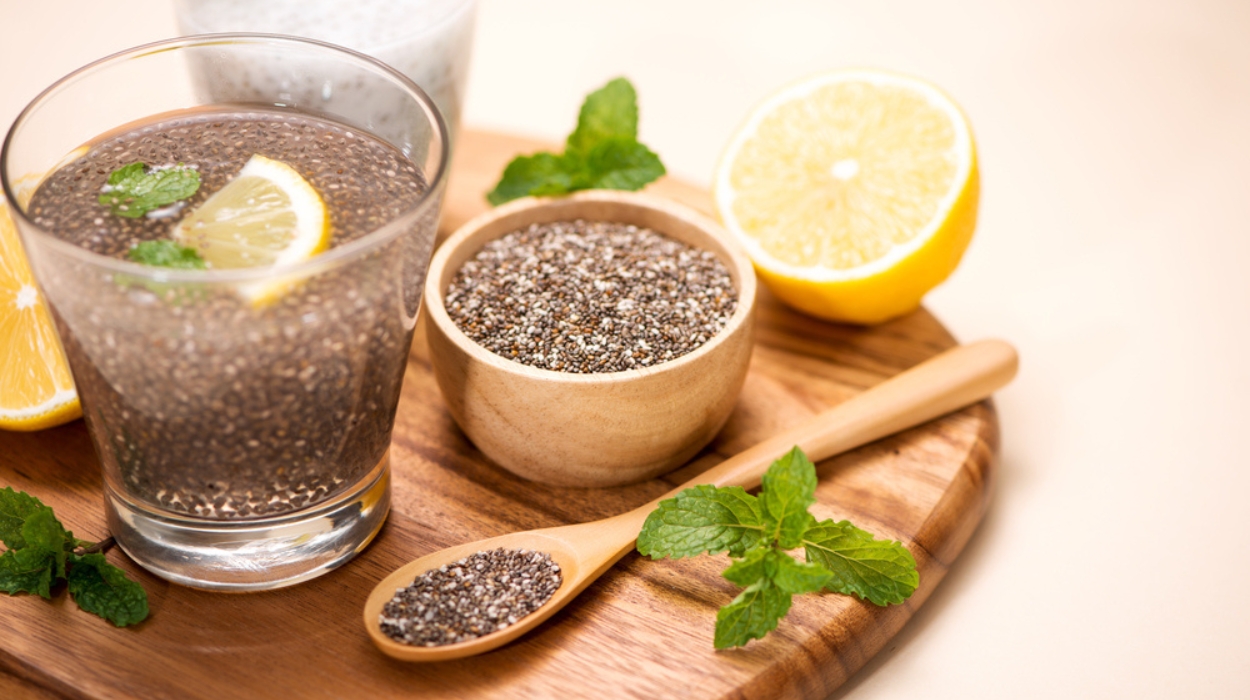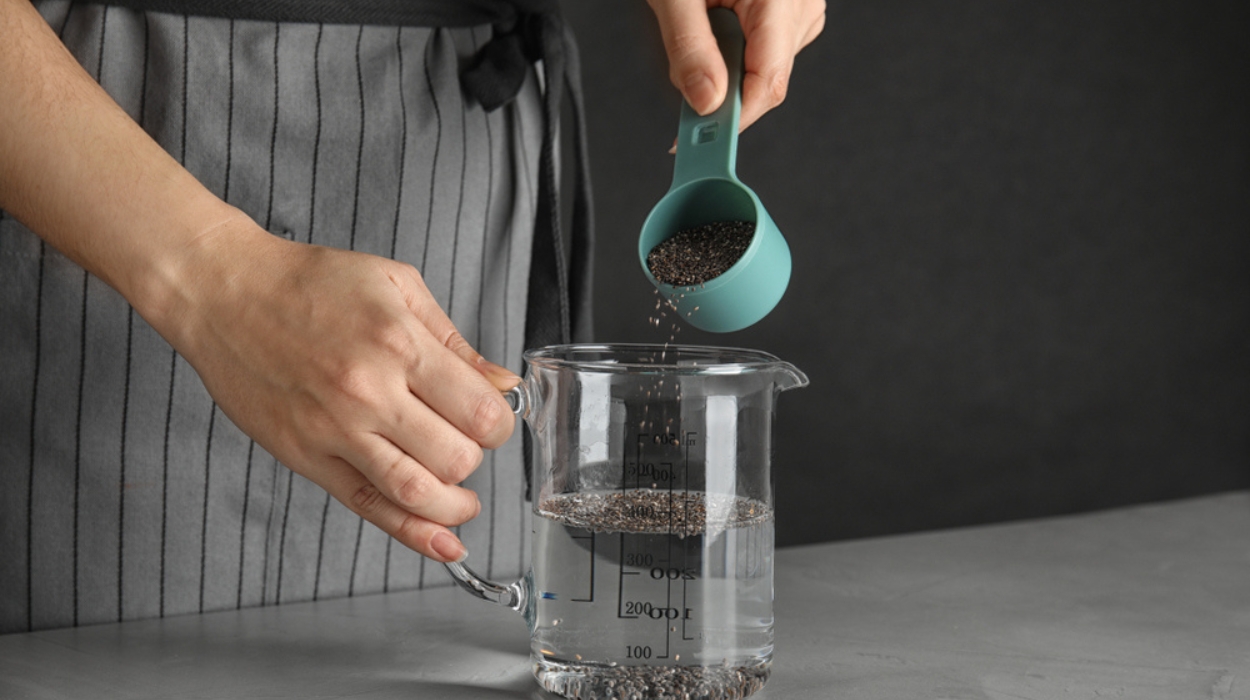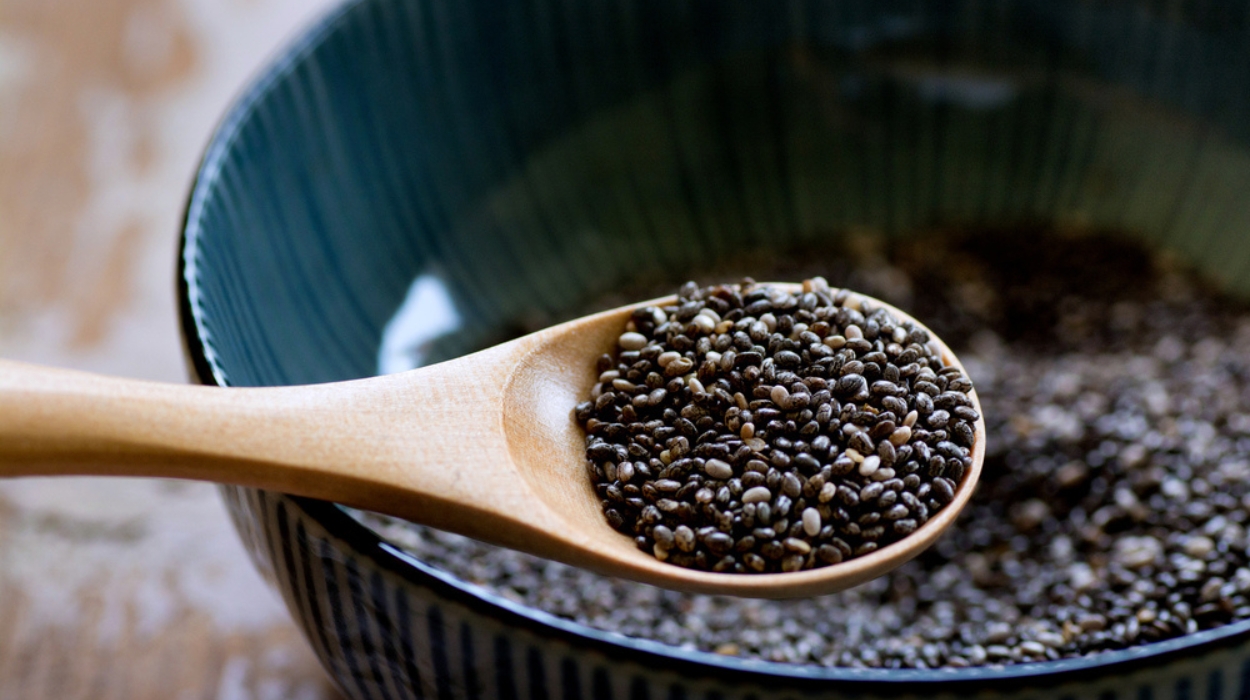Chia seeds, which are small seeds typically found in black, brown, and white colors, originated in Central and South America. Despite their size, ground chia seeds are considered a “superfood” by health experts due to their many health benefits. When chia seeds absorb water, they expand slightly and become soft and gelatinous, resulting in a smoother and creamier texture. This texture is also present when soaked chia seeds are added to milk, making it a popular ingredient in chia seed pudding.
Chia seeds are an excellent source of protein, fats, and carbohydrates, and incorporating them into the water can provide a variety of ways to enjoy their nutritional value. Consuming chia seeds in water is beneficial to overall health and well-being, and their versatility allows for a diverse range of preparation methods. Overall, despite their small size, chia seeds pack a powerful nutritional punch and offer many health benefits.
6 Benefits Of Chia Seeds In Water
- Increases fiber.
- Increases omega-3 fatty acids.
- Boosts antioxidants.
- Offers more hydration.
- Aides in weight loss.
- Blood sugar control.
Benefits Of Chia Seeds In Water
Increase Fiber
Ensuring adequate fiber intake can be difficult for busy individuals who do not have enough time to prepare fruits and vegetables. Nuts and seeds are a convenient solution to this issue, as they require minimal preparation and provide a healthy dose of fiber. When you incorporate chia seeds into your daily routine, you can add a boost of fiber to your water bottle. It’s similar to adding a pinch of sea salt to water to increase mineral intake but with the added benefit of fiber. This way, you can think of it as a fiber-infused water that can be easily prepared and consumed anytime, anywhere.
Increase Omega-3 Fatty Acids
It’s important not to fear fats. Some fats, such as saturated fats are unhealthy, whereas omega-3 fats are not only healthy, they are essential to brain, hormone, heart, gut, cellular, and overall health. Chia seeds provide these omega-3s and are easier to incorporate into the diet than other sources of healthy fats like wild-caught fish, which requires more preparation.
That being said, while chia seeds do add omega-3s, they are in the form of ALA (alpha-linolenic), which the body then converts into EPA and DHA to be used more effectively in the body. Additionally, it would take about half a pound of chia seeds to get the necessary amount of fats needed to see an improvement in health. So while chia seeds are a manageable, quick source of omega-3s, they should not be depended on solely for the daily recommended amount.
Boost Antioxidants

Antioxidants are crucial to health, especially in today’s toxic world where stress, and pollutants from the air, food, water, and electromagnetic fields are continually damaging our cells. It works to combat free radicals caused by environmental stressors which can cause cellular damage and eventual disease. Antioxidants[1] such as caffeic acid, chlorogenic acid, kaempferol, and quercetin come packed inside chia seeds, which means when you add chia seeds to water, you’re helping to protect your body against heart disease, as well as other life-threatening conditions.
Offer More Hydration
Water is often overlooked as a necessity of well-being. We think of diet and exercise but often forget to drink enough water. To take it a step further, many of us are unfamiliar with how to optimize our water so that our bodies can be better hydrated. One way to optimize hydration is by adding chia seeds to filtered water. There are a few reasons for this.
Firstly, though increasing fiber is important, it is equally important not to do so without increasing water as well (too much fiber without water can be harsh on the body). Drinking chia seeds in water helps to add the hydration component to the fiber, killing two birds with one stone. Secondly, many people struggle to drink plain water and feel they need to add a little something to it to get in as much as they need – a squeeze of lemon, berries, electrolytes, or chia seeds. Adding chia seeds to water makes it feel and taste more appealing.
Aid In Weight Loss
We need several macronutrients to keep us full – protein and fat, for sure, but also, fiber. Minimizing empty calories and increasing fiber are two key players in weight loss, and chia seeds are known for their fiber content. By adding chia seeds to water, you’re subtly adding more satiety to your day, decreasing the temptation to snack or overeat.
Helping to keep the appetite at bay is an important part of weight loss, however, it shouldn’t feel forced or restricted. This is why chia seeds in water, with their creamy texture and macronutrient profile, can provide a more natural, easier way to abstain from snacking. Some studies[2] have also suggested that chia seeds have a health-beneficial 3:1 ratio of omega 3 and omega 6 fatty acid content and decrease lipid accumulation, demonstrating their potential to reduce body fat.
Blood Sugar Control
When blood sugar is unstable we can experience anything from nausea to jitters, headaches, fatigue, and even anxiety. While the sensations of erratic blood sugar are not pleasant, the effects are even worse inside the body (systemic inflammation, hormone imbalance, premature aging, etc.). Blood sugar spikes and drops are caused by eating too much sugar and carbs without enough protein, fat, or fiber to slow down the glucose spikes and/or by going long periods of time without eating.
Sipping on chia seed water throughout the day helps to maintain steady glucose or blood sugar levels, which then leads to fewer spikes and crashes. You can also drink chia seed water during meals to help curb the glucose spike (especially if your meal is carb-heavy). Much of this is due to the fiber, fat, and protein combination chia seeds have to offer – all of the elements needed to slow down sugar absorption in the body.
Who Should Consume Chia Seeds Water?
Anyone looking to improve their health can benefit from chia seed water. That’s because chia seed water offers a lot in the way of nutrition and hydration (at the same time). Because chia seeds have a decent amount of protein, fat, and carbs, chia seed water can be good for anyone looking to increase one or more of these macronutrients. Additionally, most Americans don’t get enough fiber in their diet – as little as 7% of Americans are estimated to consume the recommended amount. If you fall into the other 93%, it’s advantageous to increase fiber slowly, and eating chia seeds is an easy and effective way to do that.
Chia seed water is also a great option for anyone looking to lose weight or increase their hydration; the fiber helps with satiety, preventing overeating, while the water provides necessary hydration. Chia seed water may also be helpful for some individuals with GI disorders, as the gelatinous chia seeds are soothing to the GI tract and provide anti-inflammatory benefits.
How To Make Chia Seeds Water?

Making chia seed water is as simple as mixing 1 tablespoon of chia seeds into 1 glass of filtered water. Soak chia seeds into the water and mix with a spoon. Let it sit for about 15-20 minutes, at which point the seeds will have expanded and become soft. Make sure to drink within two hours or store in the fridge a little longer, as the seeds may start to sprout if left out longer.
When To Drink Chia Seeds Water?
Chia water can be enjoyed throughout the day, between meals, or even during meals (though it’s not recommended to drink too much liquid during meals). Some people enjoy drinking chia seed water on an empty stomach when they first wake up in the morning. If trying to ward off hunger, it can be good to sip chia water in between meals when you start to feel peckish. There’s no wrong time to drink it.
How Long Does Chia Seeds Water Last?
After a few hours, chia seeds can start to sprout in water, essentially going bad. It’s advised to drink chia seed water within a few hours of mixing the chia seeds into the water. You may also store it in the fridge to extend this time, however, it would be most beneficial not to drink chia seed water that’s more than one day old; make a new, fresh batch each day.
Conclusion
Chia seeds are highly nutritious seeds, native to South and Central America, which when combined with water, offer a powerful and hydrating snack/drink. Adding chia seeds to water offers new ways of ingesting them to get more of the protein, fiber, fat, and antioxidants one may need in their diet. Chia seeds in water make eating the nutrient-dense seeds more accessible, and offer versatility in the way of preparation, while also offering much-needed hydration.
Frequently Asked Questions
It’s always advisable to choose filtered water over tap water, especially in some areas where the tap water does not come from its own reservoir. You may also prefer flat water rather than sparkling.
You want to add about one tablespoon for every one cup of water. If you’re making a larger batch, such as two cups of water, then just keep the same ratio.
Any time you introduce a new food you may experience some new sensations. Since chia seeds have fiber, it’s best not to introduce large amounts too soon. Start with one teaspoon a day and see how you tolerate chia seeds, then you can increase it.
 Expert's opinion
Expert's opinion
